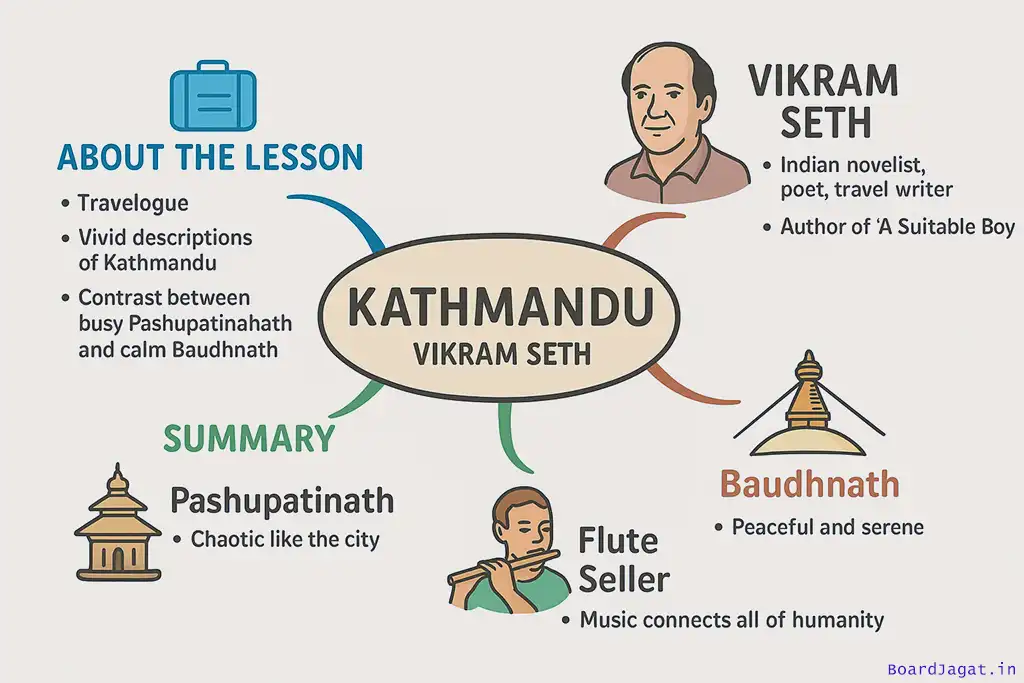Students, in this post ‘Kathmandu Summary Class 9 English’, we are covering Class 9 English (Beehive) Chapter 8 – “Kathmandu” by Vikram Seth. We’ll study about the lesson, about the author, and the summary one by one.
Kathmandu About the Lesson
The lesson “Kathmandu” is a travelogue written by Vikram Seth. It is an extract from his book Heaven Lake. In this chapter, the author describes his visit to two famous places of worship in Kathmandu – the Pashupatinath Temple (sacred to Hindus) and the Baudhnath Stupa (sacred to Buddhists). Through vivid descriptions, he shows the contrast between the noisy, chaotic atmosphere of Pashupatinath and the calm, serene environment of Baudhnath. He also captures the busy life of Kathmandu city – full of sounds, colours, vendors, music, and people. Finally, the flute seller leaves a deep impression on him, symbolising the universality of music and human emotions.
About the Author: Vikram Seth
Vikram Seth (born 1952) is a well-known Indian novelist, poet, travel writer, and essayist. He studied at Oxford University and Stanford University. He is best known for his epic novel A Suitable Boy, one of the longest novels ever published in a single volume. His works include poetry collections (Mappings, Beastly Tales), novels (An Equal Music), and travelogues (From Heaven Lake). Seth’s writing is known for its clarity, simplicity, and rich imagery. In Kathmandu, he blends observation with personal feelings, making readers experience the places through his eyes.
Short Summary of Kathmandu
In Kathmandu, Vikram Seth narrates his experience of visiting two shrines. At Pashupatinath Temple, he sees chaos everywhere; priests, worshippers, tourists, animals, and vendors fill the place with noise and confusion. He notices quarrels, rituals, and even a royal princess being respected by the crowd. In contrast, at the Baudhnath Stupa, he finds peace and stillness. The dome is surrounded by small shops run mostly by Tibetan immigrants, selling prayer items and jewellery. The city of Kathmandu itself is vibrant and noisy, with busy streets filled with hawkers, fruit-sellers, music from radios, traffic sounds, and vendors. The author indulges in local food and buys small items before deciding to head home. Finally, he is deeply moved by the flute seller, who plays his bansuri calmly in the midst of chaos. The music makes Seth reflect on the universality of the flute; every culture has some version of it, and how music connects all of humanity.
Kathmandu Summary
The chapter Kathmandu is an extract from Vikram Seth’s travelogue From Heaven Lake, where he recounts his experiences during his journey from China to India, via Nepal and Tibet. In this piece, he gives us a vivid description of Kathmandu, the capital city of Nepal.
Visit to Pashupatinath Temple:
Seth first visits the Pashupatinath Temple, a sacred place for Hindus. Outside the temple, a signboard declares that “Entrance for Hindus only”. He describes the atmosphere as full of “febrile confusion”, crowded and chaotic. Priests, devotees, hawkers, tourists, animals (cows, dogs, monkeys, pigeons) all move about noisily. People push and elbow one another to reach the priest, and foreigners dressed in saffron struggle to prove they are Hindus to gain entry. A fight even breaks out between two monkeys, adding to the commotion. On the banks of the Bagmati River, Seth observes scenes of daily life: a corpse being cremated, washerwomen working, and children bathing. He also mentions a belief that when a half-submerged shrine in the river emerges fully, the goddess will come out and the evil age of Kaliyug will end.
Visit to Baudhnath Stupa:
In contrast, when Seth visits the Baudhnath Stupa, a sacred Buddhist site, he finds a calm and serene atmosphere. The huge white dome of the stupa is encircled by a road, and around it are small shops, mostly owned by Tibetan immigrants. These shops sell items like felt bags, silver jewellery, and Tibetan prints. Unlike the noise of Pashupatinath, Baudhnath is quiet and peaceful, giving a sense of spiritual calmness.
The City of Kathmandu:
Seth then describes Kathmandu city itself. He portrays it as “vivid, mercenary, religious”, full of energy and diversity. The narrow streets are lined with shrines and crowded with hawkers selling postcards, fruit, flutes, cosmetics, chocolates, film rolls, copper utensils, and antiques. He notices the sounds of blaring film songs, car horns, bicycle bells, vendors shouting, and even cows wandering around. The author indulges in buying local items: marzipan, roasted corn rubbed with lemon, chilli and salt, comics, Reader’s Digest, Coca Cola, and a cheap orange drink. These small experiences bring him comfort in the bustling city.
Decision to Return Home:
Seth reflects on his journey and considers different routes to return to India, including one through Patna and along the Ganga. However, because he feels tired and homesick, he decides to take a direct flight to Delhi.
The Flute Seller:
Before leaving, he is struck by the sight of a flute seller standing in a corner with dozens of flutes stuck into a pole like porcupine quills. The man plays the flute softly and meditatively, without trying hard to attract buyers. Occasionally he sells one but treats it casually, as if selling is secondary to his love of playing.
The music of the flute touches the author deeply. He reflects on how the flute exists in almost every culture: the bansuri in India, the shakuhachi in Japan, the recorder in Europe, the reed flute in the Middle East, and many more. Though they differ in sound and style, all flutes are linked by the common breath of human life. To him, the flute represents universality, simplicity, and shared human emotions.
Conclusion:
Thus, Kathmandu presents a travel experience that moves from the chaos of religious practices at Pashupatinath, to the calm of Baudhnath, to the vibrant streets of Kathmandu, and finally to the timeless universality of music. Through his keen observations, Vikram Seth captures both the external sights and internal reflections of his journey.

Read Also: Kathmandu Class 9 NCERT Solutions
View all Chapter: Class 9 English NCERT Solutions